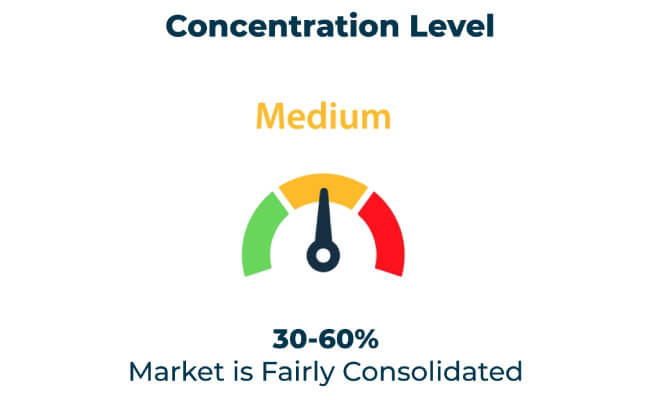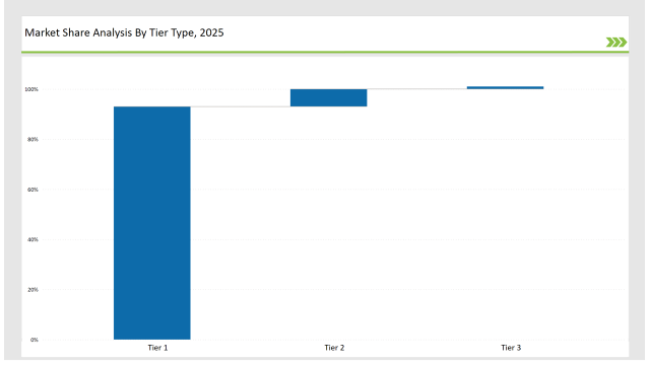Sleep Apnea Implants Market Share Analysis Outlook for 2025
The Sleep Apnea Implants Market is in strong growth mode, driven by technological advancements and increasing patient preference for implant-based therapies over traditional CPAP devices. The three major players hold 92.6% market share: Inspire Medical Systems, Respicardia, Inc., and Medtronic Plc.
Inspire Medical Systems continues to lead with AI-driven hypoglossal nerve stimulation technology through strategic partnerships and reimbursement expansions worldwide. Respicardia, Inc. has solidified its standing in the treatment of central sleep apnea through its phrenic nerve stimulation technology, meanwhile Medtronic uses its strong background in neuromodulation for the development of its future implantable solutions with real-time monitoring functions.
While niche players such as Pillar Palatal LLC / The Snoring Center, Siesta Medical, Inc., and LivaNova/ImThera hold a market share of 6.5%, their focus on the minimally invasive solutions like the tongue suspension implant and palatal implant, in mild-to-moderate obstructive sleep apnea patients, is expected to drive segmental growth through patient-specific treatment approaches.
| Attribute |
Details |
| Estimated Value by 2025 |
USD 466.6 million |
Chinese players are gaining a foothold in the market by investing in indigenous implantable sleep apnea technologies and expanding their clinical trials. Companies in China focus on cost-effective neurostimulation solutions and are integrating AI-driven diagnostics to further improve patient outcomes. The support of the Chinese government for local medtech startups and regulatory reforms aimed at speeding up device approvals is furthering competition in the market.
With changes in the vendor landscape, new reimbursement policies, and the introduction of new market players, market growth will continue to accelerate during the coming years. Rising use of smart implants, combined with the increasing incidence of sleep apnea, is expected to foster a dynamic, competitive market environment that ensures increased accessibility and improved patient outcomes for all patients.
Explore FMI!
Book a free demo
Global Market Share by Key Players
| Global Market Share, 2025 |
Industry Share % |
| Top 3 (ResMed, Inspire Medical Systems, LivaNova) |
50% |
| Rest of Top 5 (Medtronic, Nyxoah) |
30% |
| Emerging & Regional Players |
20% |
Market Concentration

Segment Analysis
Product Segmentation
- Phrenic Nerve Stimulator: In this devices, the technology helps restore the normal breathing cycle, reduces reliance on external assistance for breathing, and improves the long-term results for the patients. With advancements in battery life and implant miniaturization, the devices are more efficient, decrease complications, and enhance patient adherence. The devices integrate remote monitoring capabilities, so that healthcare providers can track patients' progress in achieving optimal adjustments in therapy with long-term effectiveness in managing central sleep apnea.
- Hypoglossal Neurostimulation Devices: The hypoglossal neurostimulation devices stimulate the hypoglossal nerve, thus preventing sleep-related airway collapse and hence reducing the episodes of apnea. These minimally invasive implants are an alternative to CPAP therapy for patients with moderate to severe OSA who have been resistant to mask-based treatments. The latest advanced designs of the devices ensure patient comfort, optimal stimulation control, and long-term compliance. Additionally, integrated remote monitoring capabilities allow physicians to track patient progress, adjust therapy settings, and maximize treatment efficacy. With growing clinical success, these devices are becoming a preferred solution for OSA management, driving market adoption worldwide.
- Bone Screw Implant System: The system stabilizes the airway by anchoring soft tissue to the bone and reduces upper airway obstruction while improving airflow during sleep. This provides structural support to prevent the airway from collapsing, hence offering a long-term solution to patients who fail to respond to CPAP or other non-invasive treatments. This implant system is becoming popular as it is strong, easy to implant, and consistent in delivering the results. Recent developments in this system have made this treatment more comfortable for the patients, reduced the risks associated with surgery, and maximized the potential impact of this treatment on people suffering from moderate to severe sleep apnea.
- Flexible Tongue Retractor System: It mechanically repositions the tongue while avoiding airway obstruction and lowering the severity of apnea. It is a non-invasive alternative to neurostimulation therapy that offers relief for patients who cannot tolerate CPAP treatment. Its adjustable design ensures a comfortable fit for each patient, making it easier to adhere to over the long term.
- Palatal Implants/Pillar Procedure: Small-sized rods implanted through the soft tissue to stiffen it and eliminate airway collapses. This surgery is minimally invasive, yet successful in severe and moderate degrees of OSA.
Indication Segmentation
- Central Sleep Apnea: It is an instance where there is failure in this nerve signal being appropriately carried down to the respiratory muscles.
- Obstructive Sleep Apnea (OSA): This is the most common type of sleep apnea that is characterized by cessation of airflow during sleep via an obstruction within the airway. The treatment for mild and severe forms of OSA involves the use of hypoglossal nerve stimulators and palatal implants.
End User Segmentation
- Hospitals: The biggest group of end-users are hospital settings, where most sleep apnea devices are surgically implanted; they possess proper facilities and experts in their care.
- Ambulatory surgical centers: Ambulatory surgical centers offer low-cost, minimally invasive outpatient treatments that reduce hospital stay and enhance access for patients to sleep apnea implants. Their streamlined approach improves on treatment efficiency, shortens recovery times, and expands access to specialized care.
- Clinic-based practices: Office-based treatments are becoming more prevalent, especially for minimally invasive treatments such as palatal implants and tongue retractors. Patients are offered greater convenience and comprehensive postoperative management.
Who Shaped the Year
2024 has seen groundbreaking innovations in sleep apnea implants, with leading players making significant advancements in product development and patient accessibility
- ResMed: AI-enhanced neurostimulation and remote patient monitoring.
- Inspire Medical Systems: Advancing hypoglossal nerve stimulation technology.
- LivaNova: Improving phrenic nerve stimulation implant durability.
- Medtronic: Integrating machine learning in sleep apnea therapy.
- Nyxoah: Developing personalized implantable solutions for sleep apnea.
Key Highlights from the Forecast
- Rising Adoption of Hypoglossal Nerve Stimulators: Increasing patient preference for minimally invasive alternatives to CPAP therapy.
- Increased Utilization of Minimally Invasive Procedures: Growing preference for palatal implants and tongue retractor systems due to shorter recovery times and higher patient compliance.
- Market Growth in Emerging Regions: Expanding access to sleep apnea treatment solutions in developing healthcare markets.
Tier-Wise Company Classification 2025
| Tier |
Market Share (%) |
| Tier 1 (Inspire Medical Systems, Respicardia, Inc. and Medtronic Plc) |
92.6% |
| Tier 2 (Pillar Palatal LLC / The Snoring Center, Siesta Medical, Inc. , LivaNova/ImThera) |
6.5% |
| Tier 3 (Regional & Emerging Players) |
0.9% |

Key Company Initiative
| Company Name |
Unique Initiative |
| Inspire Medical Systems |
Pioneers AI-driven hypoglossal nerve stimulation devices with improved remote monitoring capabilities. |
| Respicardia, Inc. |
Expanded clinical trial programs in central sleep apnea through phrenic nerve stimulation therapy. |
| Medtronic Plc |
Modular neurostimulation implants with real-time AI adjustments and increased battery life. |
| Pillar Palatal LLC / The Snoring Center |
Specializes in minimally invasive palatal implants for reducing snoring and mild obstructive sleep apnea. |
| Siesta Medical, Inc. |
Innovates with minimally invasive tongue suspension implants designed for personalized airway management. |
| LivaNova/ImThera |
Advances hypoglossal nerve stimulation with multi-electrode stimulation for more precise airway control. |
| Nyxoah SA |
Develops leadless neurostimulation implants with wireless activation and expanding presence in European markets. |
| LinguaFlex LLC |
Focuses on flexible, adjustable tongue implants with customizable settings to improve patient-specific outcomes. |
Recommendations for Brands
- AI-Based Sleep Monitoring: The companies need to integrate AI and remote monitoring in sleep apnea implants, thereby enhancing personalization of the therapy and ensuring compliance among the patients.
- Penetration of the Emerging Markets: Expanding the distribution network and getting regulatory approval in high growth areas will spur broader market penetration.
- Advanced Minimally Invasive Technology: Smaller, longer lasting implants with comfort and efficiency are expected to have a higher uptake rate.
Future Roadmap
- AI-Powered Sleep Apnea Management: Integration of predictive analytics and real-time monitoring for optimized treatment outcomes.
- Enhanced Battery Life for Implantable Devices: Development of long-lasting implant solutions, reducing the need for frequent replacements.
- Expansion of Minimally Invasive Treatment Options: Introduction of new soft tissue implants and bioengineered solutions to reduce airway obstruction.
- Global Market Expansion: Increasing adoption of sleep apnea implants in emerging healthcare markets to improve accessibility and affordability.
Frequently Asked Questions
Which Companies hold significant share in the Sleep Apnea Implants market?
Inspire Medical Systems, Respicardia, Inc. and Medtronic Plc command about 92% share in the global market.
What was the worth of the Sleep Apnea Implants market in 2025?
The global Sleep Apnea Implants market represents a sale of USD 466.6 million in 2025.
How much share does regional and domestic companies hold in the market?
Regional and domestic companies hold nearly 56% of the overall market.
Which speciality sector offering significant growth potential to market players?
Hypoglossal Neurostimulation Devices offering significant growth prospects to market players.


